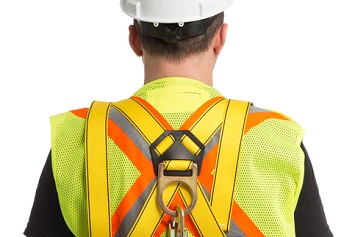Every so often, your facilities management team members will find themselves on scaffolds, platforms, or scissor lifts. Whether you’re performing new construction or routine maintenance, fall protection must be addressed whenever an employee is working at heights. Is adequate railing protection enough? Can you require use of a fall arrest system even when one isn’t technically needed? Read on here for answers to these two questions.

Q: Do we need a fall protection plan and personal fall arrest systems if our scaffolds and platforms have adequate railing and protection from fall hazards?
A: If your scaffolds and platforms have adequate railing and protection from fall hazards, you will not need a fall protection plan and you will likely not need personal fall arrest systems unless you are using specific types of scaffolds.
To address the first part of your question, in California, a fall protection plan is only required if it can be shown that the use of a conventional fall protection system (such as a guardrail system, safety net, or personal fall arrest system) is impractical or creates a greater hazard. Therefore, if your worksite has adequate guardrails (as described in 8 CCR 1621(a)) and fall protection, a fall protection plan would not be needed. (8 CCR 1671.1)
To address the second part of your question, in general, personal fall arrest, personal fall restraint or positioning systems must be worn by construction workers in California whose work exposes them to falling in excess of 7.5 feet from the perimeter of a structure, unprotected sides and edges, leading edges, through shaftways and openings, sloped roof surfaces steeper than 7:12, or other sloped surfaces steeper than 40 degrees that are not otherwise adequately protected. Because scaffolds must have guardrails installed on open sides and ends of platforms that are 7.5 feet or higher, the edges would not be unprotected. Therefore, where there are sufficient guardrails, personal fall arrest, personal fall restraint, or positioning systems are not required.
However, the following types of scaffolds require the use of a personal fall arrest system, personal fall restraint system, or positioning device due to the impracticability of guardrails:
- Boatswain’s chairs
- Float scaffolds
- Needle beam scaffold (may also use safety net)
- Suspended scaffolds
Q: In the event an elevated scissor lift has an adequate guardrail system, can the employer exceed this requirement and request a fall arrest system as well?
A: Yes, an employer may require the use of a fall arrest system in addition to an adequate guardrail system. However, an additional fall protection device is only required if the guardrail system is inadequate or a worker leaves the work platform.
Scissor lifts are regulated under the federal scaffold rules for construction. When scissor lifts are used in general industry, the General Duty Clause applies. However, the construction rules inform OSHA’s evaluation of whether a general industry employer has provided a workplace “free from recognized hazards that are causing or are likely to cause death or serious physical harm.…”
Because scissor lifts meet the definition of a scaffold, employers must comply with the applicable provisions of 29 CFR 1926 Subpart L. This includes the requirement that employees be protected by the use of personal fall arrest systems or guardrail systems when working from “scaffolds not otherwise specified” in 29 CFR 1926.451(g)(1).
As further explained in a Letter of Interpretation dated July 21, 1998, OSHA stated that when working from an elevated scissors lift, a worker need only be protected from falling by a properly designed and maintained guardrail system. If the guardrail system is “less than adequate, or the worker leaves the safety of the work platform, an additional fall protection device would be required.”
With that being said, many employers also choose to require the use of personal fall arrest system to eliminate further risks of falls from scissor lifts. While guardrails are acceptable forms of fall protection, workers could still fall through the space below the mid-rails or over the top rail. Depending on the fall hazards present at your workplace, you should evaluate the risks and provide the appropriate fall protection measures.
As a final note, if you choose to use personal fall arrest systems in addition to the guardrail system, the personal fall arrest system must be anchored to an approved anchor point on an adjacent structure or the scissor lift itself, and never to a guardrail.
Note: These questions were answered by experts at Safety.BLR.com. If you would like to take a free trial of this safety resource, click here.
